#aperiodic
Text
I always liked complex patterns that were created using a single tile. For example, the following pattern looks rather complex at first glance.
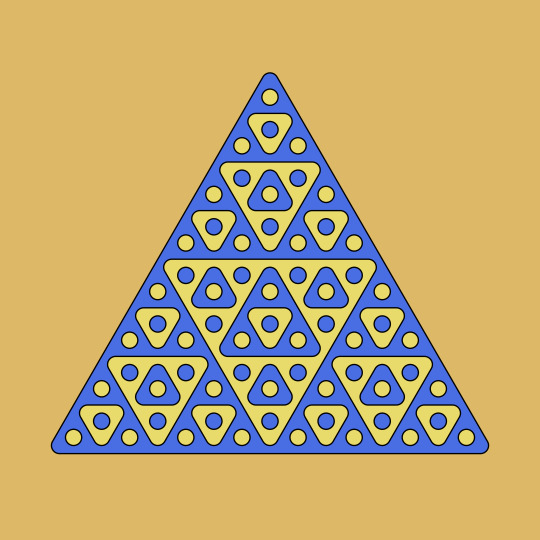
But it is actually created using a single hexagonal tile.
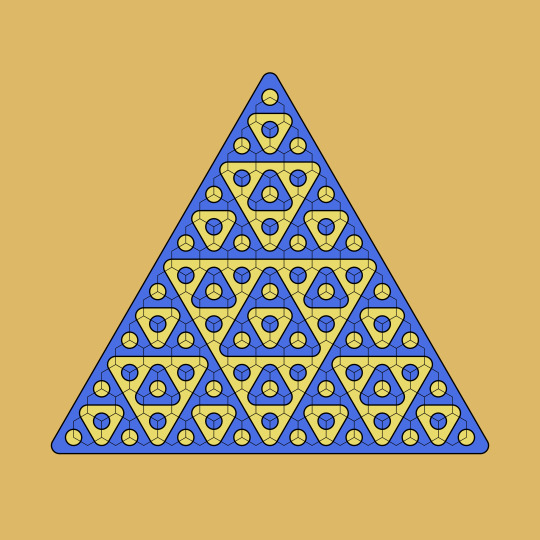
The idea came from a board game called Palago which uses exactly these tiles. Here is the middle part of the pattern using actual tiles. Unfortunately I don't have enough tiles to create the next level.
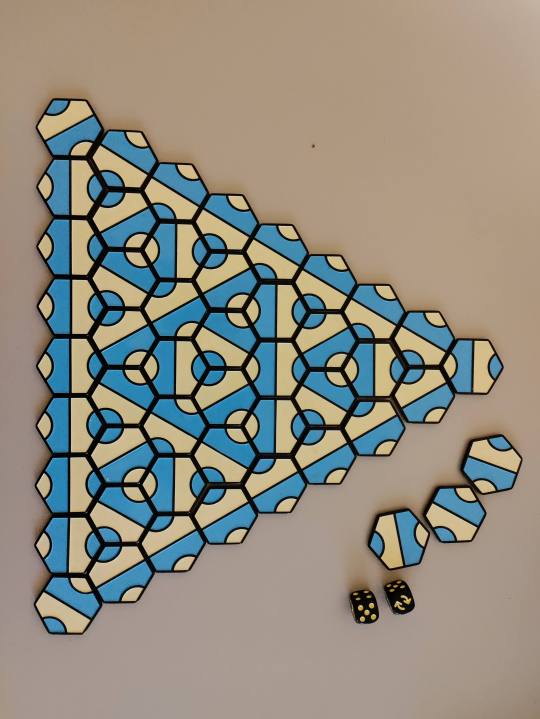
Another interesting property of this pattern is that it can be extended into an infinite pattern which is aperiodic. This pattern shows up for example in the tiling of the aperiodic tile found by Joshua E. S. Socolar and Joan M. Taylor. (Not to be confused with the recently found aperiodic monotile by David Smith, Joseph Samuel Myers, Craig S. Kaplan and Chaim Goodman-Strauss)
424 notes
·
View notes
Text
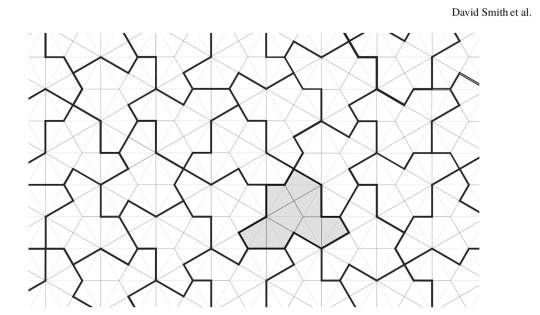
Aperiodic Monotile
Super big news from this lot. (ArXiv)

A monotile that admits no periodic tilings, but uncountably many aperiodic tilings. WOW.
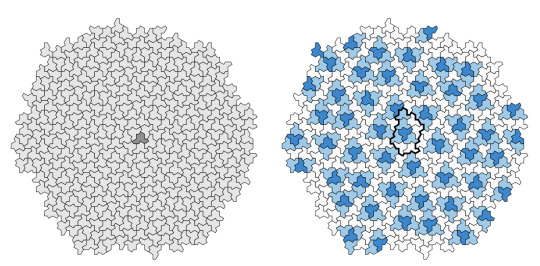

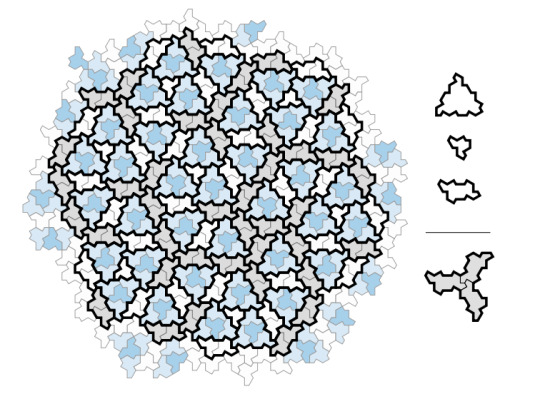


And they're calling it the Hat.
And Craig announced it with an animation!
youtube
159 notes
·
View notes
Photo
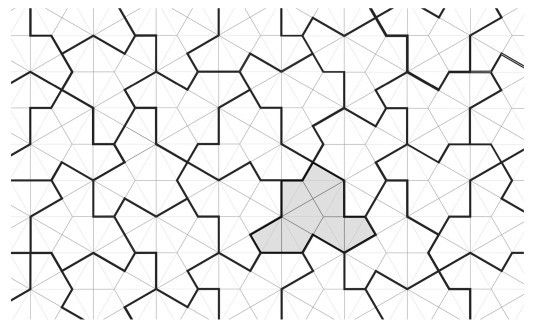
https://arxiv.org/pdf/2303.10798.pdf
93 notes
·
View notes
Text
Meet Jade! She runs her own YouTube channel, and she calls it Up and Atom. Today she reports on a breakthrough in mathematics: a single aperiodic tile named “the einstein tile”.
7 notes
·
View notes
Text
An aperiodic tiling discovery
Much excitement last week with the publication by David Smith, Joseph Myers, Craig Kaplan and Chaim Goodman-Strauss of their discovery of a single tile which tiles aperiodically. Not only that but it does not need any supplementary rules, as Penrose's dart/kite pair do, to ensure aperiodicity. Christian Lawson-Perfect wrote about the story in aPeriodical. Later: There is now an excellent online talk by Craig and Chaim on the discovery and its proof hosted by the National Museum of Mathematics in New York.
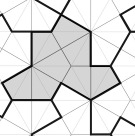
The shape was discovered by David Smith, a hobbyist geometer. There is a wealth of research in David's blog, which starts with the declaration "I am not a mathematician but I do like shapes, interesting symmetry, polyhedra, tessellations and geometric patterns. " Skimming though it, one can see the deep exporation of shapes which makes his discovery seem almost inevitable. I plan to read more of his blog for inspiration. Well done ye, David!
The mathematical work of proving that the tile is aperiodic is a masterful exercise, clearly explained. A truly inspiring collaboration between a tinkerer, acedemic mathematicians and computer scientists.
OpenSCAD
Naturally I had a look at this with my OpenSCAD tiling tools.
tl:dr: A customizer on Thingiverse.allows both kinds of tiles in normal or mirror forms and all intermediate tiles to be printed or laser-cut.
I began by defining the perimeter as a sequence of sides each defined by side length and interior angle taken from the diagram, where we see up of 16 right triangular segments ( 8 kites) of adjacent hexagons. In this formulation, r is the long side of the triangle, a and b the other sides.
function hat_peri(r) =
// r is the radius of the base hexagon
// returns perimeter as a sequence of [side length,internal angle]
let (a = r * sin(60), b = r*cos(60) )
[[b,180],[b,120],[b,270],[a,120],[a,90],[b,120],[b,270],[a,120],
[a,90],[b,240],[b,90],[a,240],[a,90],[b,120]];
The first two sides form a straight line but for the purposes of tiling are distinct edges.
The perimeter is converted to a sequence of points using turtle-like geometry:
function peri_to_points(peri,pos=[0,0],dir=0,i=0) =
i == len(peri)
? [pos]
: let(side = peri[i])
let (distance = side[0])
let (newpos = pos + distance* [cos(dir), sin(dir)])
let (angle = side[1])
let (newdir = dir + (180 - angle))
concat([pos],peri_to_points(peri,newpos,newdir,i+1))
;
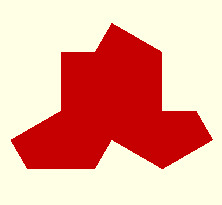
Tiling with this shape requires the use of the mirror image of the base tile:
function reverse(l) =
[for (i=[1:len(l)]) l[len(l)-i]];
function mirror_peri(q) =
let(p=reverse(q))
[for (i=[0:len(p)-1])
[p[ (i - 1 + len(p) ) %len(p)].x,p[i].y]
];
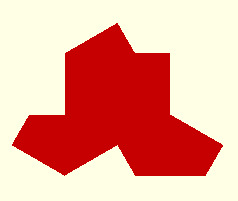
[This is a bit of a pity. Penrose's tiles are symmetric so the question doesnt arise but the search continues for a monotiling which does not require the use of reflections.]
My library of OpenSCAD functions supports the creation of tilings by defining a sequence of edge-to-edge placements. ATM this list is created manually. Each line specifies the alignment of one of the base tiles and edge to a tile and edge in the assembly.
hat_assembly_6 = [
[[0,0]]
,[[0,0],[0,1]]
,[[0,5],[0,2]]
,[[0,3],[0,4]]
,[[0,13],[0,6]]
,[[1,1],[0,9]]
,[[0,7],[0,12]]
];
module hat_tile_6(d) {
p = hat_peri (10,d);
t=peri_to_points(p);
m=peri_to_points(mirror(p));
unit=group_tiles([t,m],hat_assembly_6);
fill_tiles(unit,["red","green","blue","yellow","pink","black","coral"]);
}
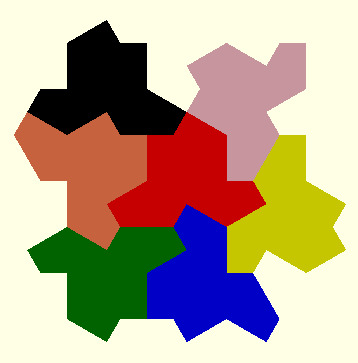
Parametric tiles
More amazingly still, this tile turns out to be one of a family of aperiodic tiles, which in the limit are simple periodic tiles. They are beautifully animated here. The parametric perimeter description enables all members of this family to be constructed:
function hat_peri_family(r,d) =
// r is the radius of the base hexagon
// d is the angle which varies from 0 to 90
// returns perimeter as a sequence of [side,internal angle]
let (a = r * sin(d), b = r * cos(d) )
[[b,180],[b,120],[b,270],[a,120],[a,90],[b,120],[b,270],[a,120],
[a,90],[b,240],[b,90],[a,240],[a,90],[b,120]]);
At the limits , the tiles tesselate:
d=0 (nicknamed the comet)
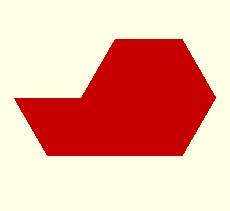
d=45

d=90 (nicknamed the chevron)

All the tiles inbetween are aperiodic:

The Turtle
David also discovered a second tile he called the turtle. Defined as a perimeter, this also has 14 sides and is a family of tiles:
function turtle_peri(r,d) =
// r is the radius of the base hexagon
// returns perimeter as a sequence of [side,internal angle]
let (a = r * sin(d), b = r * cos(d) )
[[a,240],[a,90],[b,240],[b,90],[a,120],[a,180],[a,120],[a,270],[b,120],[b,90],[a,120],[a,270],[b,120],[b,90]];
d=60
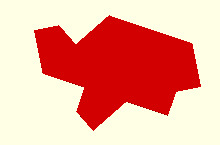
The periodic endpoints d=0 and d=90 are the same as for the hat.
This is a small section of a tiling in David's blog:
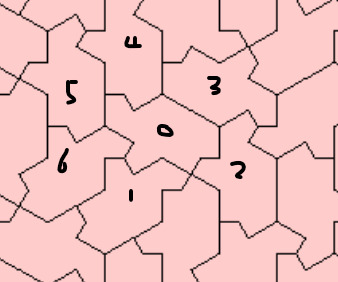
No mirroed tiles in this example.
turtle_assembly_6 = [
[[0,0]]
,[[0,12],[0,13]]
,[[0,13],[0,2]]
,[[0,5],[0,6]]
,[[0,4],[0,7]]
,[[0,5],[0,10]]
,[[0,10],[0,11]]
];

To do
I'd like to add a couple of the suggested decorations.
A big task is to automate the tile placement to construct an assembly. Craig's software does this so I dont expect it to be easy! The approach I'd like to explore (perhaps it's the obvious appraoch?) is to start with the perimeter description of the base tile and extend this as each tile is added. The next tile can be placed by matching a subsequence of the tile perimeter to a subsequence of the expanding perimeter. Bit complicated to ensure that such a match will result in a fit especially with concave shapes.
Further
Veritasium has a nice youtube on the background to aperiodic tiling
Jaap Scherphuis created the PolyForm Puzzle software which was used by David in his explorations.
7 notes
·
View notes
Text
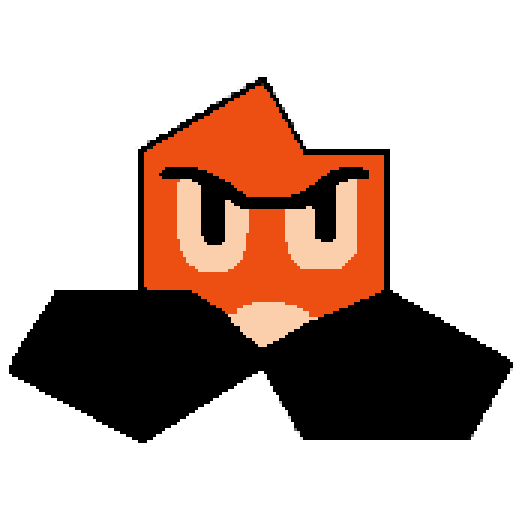
2 notes
·
View notes
Text
The Hat : New shape answers a 50-year-old geometry mystery
A group of four scientists have discovered an entirely new shape which has 13 sides and has named it “the hat”. It is the first ‘einstein’ tile to have been found: a shape that can cover a plane without overlapping, leaving gaps, or repeating patterns. The name bears no connection to Albert Einstein but means ‘one stone’ in German. The shape is a polykite with the edges of eight kites to make it.…

View On WordPress
0 notes
Text
Teen girl nice ass in tight sweatpants
Ebony group fucked in public bar bdsm
Sensual Lesbian Teens Toy Each Other
Desi GF Fucking Hard
Femdom session with sissy boy and two mistresses
la guasona del hotel liverpool,merced
Father Fucks Daughters Doggy one at a time
Busty blonde Anita Blue sucks a big black cock
Madura cameltoe y voyeur mix
Greek Milf sucks and rides dick and makes me cum too fast
#tramming#frivolers#ventrocaudal#sastiel#racially#protoepiphyte#gastroenterology#prosopography#Cornwall#jingoistically#aperiodic#nonacoustical#tectological#insensibility#prerevising#countercathexis#premonitor#hemofuscin#VO#unstavable
0 notes
Text
Hey so you remember this thing that everyone on mathblr got excited about recently?

This is the hat, and it's what's called an "aperiodic monotile". This means that no matter how you arrange copies of this tile, you can never get an arrangement that will repeat infinitely (think of it like the irrational numbers of tilings). This was big news in mathematics as while sets of more than one tiles have been found that are aperiodic (e.g: The Penrose Tiles), this was the first tile that's aperiodic by itself, hence "monotile". (There are some caveats to this but that's not important for understanding this post)
However.
If you look at images of the hat tiling, you may notice something.
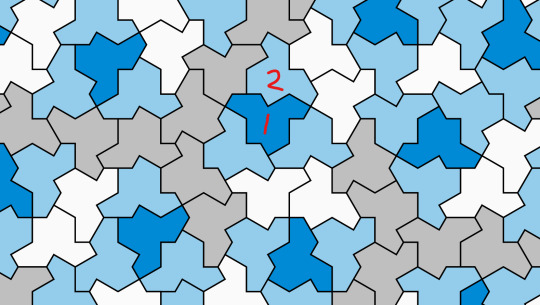
If you look at the tiles labled 1 and 2, you'll see that one's a reflected copy of the other. In fact, any infinite arrangement with hats requires you to you mix unreflected and reflected tiles. Which raises the question: is it possible to have an aperiodic monotile that doesn't need reflections?
Presenting the Spectre, A chiral aperiodic monotile.

Using only translation and rotation, any arrangement of copies of this tile will never repeat.

Mathematically speaking, this is really fucking cool.
The paper on it is still in preprint, but hopefully I won't need to retract this post. A copy of it can be found here and a post going into some more details of how the shape was discovered is here.
#I know not a lot of people who follow me are interested in maths#It's not stopping me though.#I WILL talk about maths and you WILL hear me#Apologies if I've made any mistakes#math#maths#aperiodic monotile#spectre
3K notes
·
View notes
Text


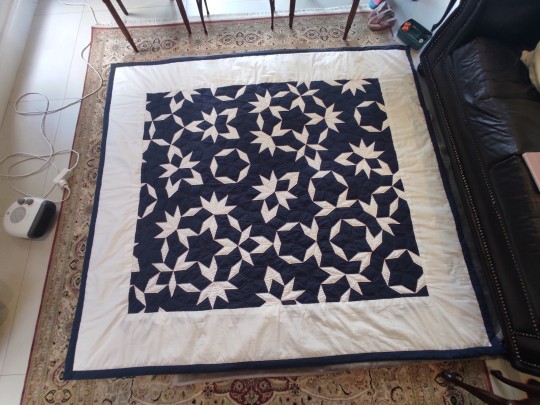

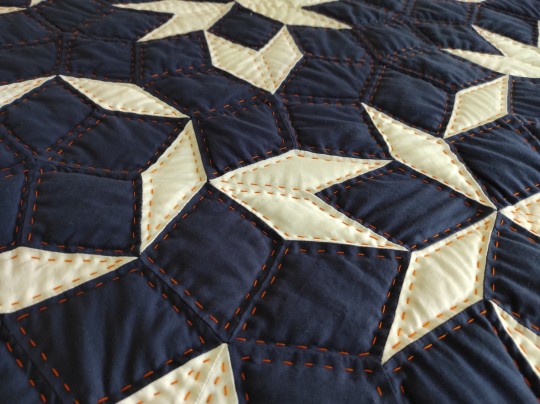
Penrose quilt is officially finished! 2022-07-30 to 2023-04-02, all hand sewn by me and my mother.
It would figure that the Einstein would be found like a month before I finished this! Honestly probably for the best, the Einstein has too many concave angles.
We'll embroider patches for it soon but for now we're calling it, it still needs its first wash and I'll probably have to patch up some quilting after that.
2K notes
·
View notes
Text
the Spectres aren't just a few shapes.
they're an infinite family of shapes.
a family that includes this:
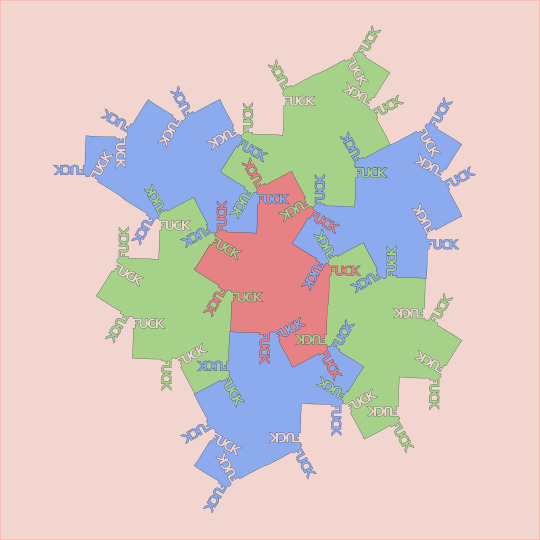
i'm naming this particular shape
The Fuckre
#made this in inkscape manually#gonna try to make a geometry nodes that can do this with blender#aperiodic monotile#aperiodic tiling#geometry#mathematics#math#mathblr#shapes#tiling#tesselation#spectre#spectres#the spectres#the spectre#inkscape#vector art#fuck
533 notes
·
View notes
Text
In the math camp I also received a marvelous gift. A large set of Penrose tiles made from wood!

116 notes
·
View notes
Text
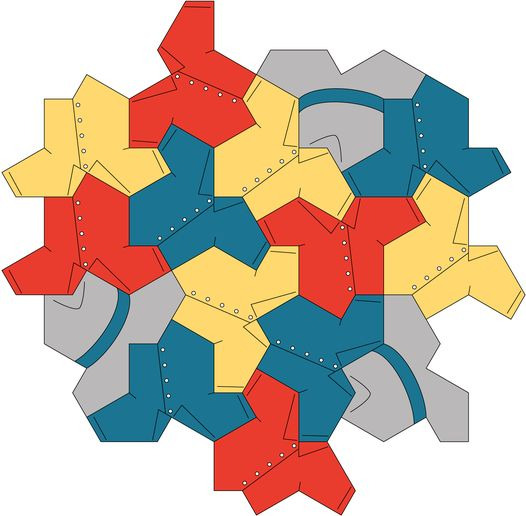
Robert Fathauer Hat Tiling
Made to congratulate Dave Smith, Joseph Myers, Craig Kaplan, and Chaim Goodman-Strauss for discovering an aperiodic monotile
102 notes
·
View notes
Text
hat out of aperiodic monotiles is finally done!!!


the pattern for the individual hats can be found here 🧶🎩
#this is it my hats of hats that is kinda like a beret kinda like a beanie and 100% aperiodic#knitting#fiber arts#mathblr#🧶🪳#🐌
256 notes
·
View notes
Text
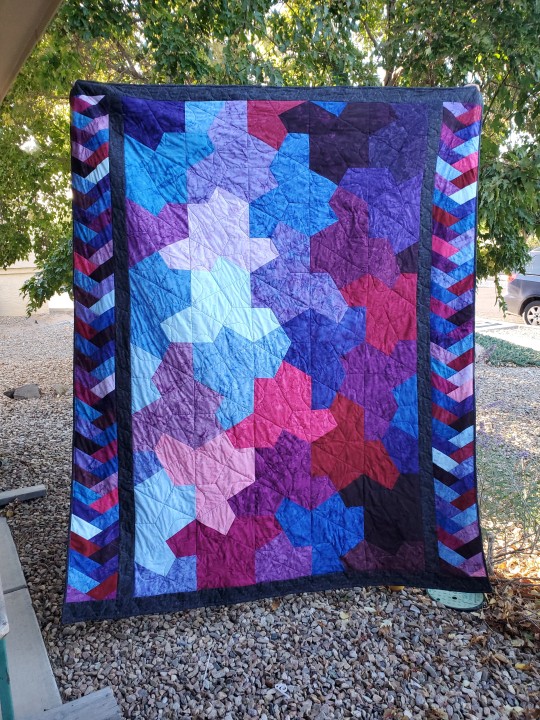
Finished my einstein tile quilt!!! I wanted to have the braid go all the way around but I was 2 feet short 🥲
Luckily I'm still really happy with how it turned out
213 notes
·
View notes
Text
NEW SHAPE DROPPED

Spectre
As a refresher on tiling:

The above image is an example of penrose tiling. It lacks translational symmetry, but it does have reflection and fivefold rotational symmetry. It's very cool but note that it has two different "shapes", two rhombi.
Below us is Hat!


Hat is a tile that is especially cool because you only need itself and a reflection of itself to make a provably aperiodic tiling!
It is kind of a whole wiggly range of similar shapes (like if you tweak the edges a little it can still repeat) BUT it requires a reflection of itself, which is kind of using *two* shapes. Spectre, however, only needs itself:

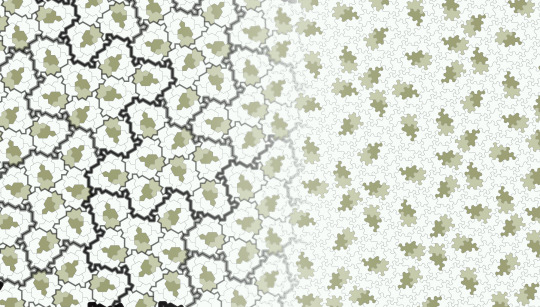

You can read about Spectre here!
Like Hat, it also can exist as a range of slightly similar shapes! For example, here's doggy : )

359 notes
·
View notes